|
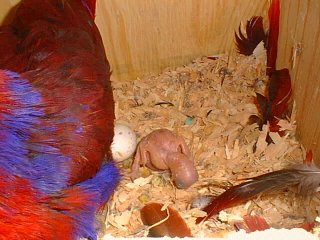
Usually large parrots are reproduced in captivity as single pairs in a flight or suspended cage depending on the species. Many smaller species do well in a colony situation, the three most common being the Budgerigar, Peach-faced Lovebird and the Cockatiel.
These, however, are small psittacines that are flocking birds in their natural habitats. Several of the Australian parakeets have also been successfully bred in colonies; these include the Princess-of-Whales, Rock Pebbler, Swift and Bourke's Parakeets. Two small New World hookbill that are often colony bred are the Quaker (Musk) and the Lineolated (Barred) Parakeets.
One need only to see photographs or to observe the Quaker in the wild to know that this species prefers to reproduce in very large colonies using extensive nests of dried twigs and flexible branches. Other parrot species successfully but less often bred in colonies include Caiques, Brotogeris, Scarlet-chested Parakeets and a few others.
The most important aspects of successful captive reproduction in a colony are: 1.) the total amount of space available for the colony, 2.) the number of pairs housed together, 3.) the strength of individual pair bonds and 4.) the number of nests and where they are placed within the aviary.
As one would expect, the larger the birds, the larger the aviary should be for successful reproduction. In the wild, the larger parrots nest further away from each other and occupy greater territories. Many of the larger parrots are very territorial during the breeding season and will defend their nests vigorously from birds, particularly those of their own species.
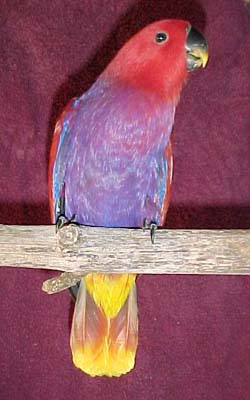
During the years of 1977-1988, when working at Aviculture Institute, I had the privilege of reproducing a great number of parrot species. One of these was the Eclectus Parrot which soon became a great favorite. In fact, Aviculture Institute received a Gold Propagators Award in 1985 from the AZA (then the AAZPA). This award was established to acknowledge the successful reproduction of 100 or more clutches of eggs of an avian species. The species for which we gained the award was Eclectus roratus vosmaeri. We eventually raised over 500 Eclectus young.
During this time we had several pairs of Eclectus that continually laid clutches of infertile eggs. We switched mates and even fostered fertile eggs under infertile pairs, hoping to trigger fertility. The infertile pairs hatched, fed and reared the babies that were fostered under them, but when they laid their own next clutch of eggs, they were infertile again.
In frustration, and sometimes desperation, I considered colony breeding a group of the infertile pairs. Within the Eclectus group of parrots, it is the female which is dominant, although I have never had a female injure or maim her male, even if he was afraid of her. The female would usually exert her dominance by taking the highest position in the cage or by being the first one at the food dish. Sometimes a female would move the male off the perch she occupied and the male would have to climb the wire next to the perch. In suspended flights, the male would climb down the wire to the floor.
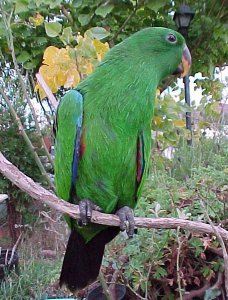 In the 1980's, we housed Eclectus pairs in flights which had cement floors. Each flight was 4 ft. in width, 12 ft. in length, and 8 ft. in height. Pairs of Eclectus were not housed next to each other, but were separated by flights containing small to medium sized cockatoos (Goffin's, Citron, Red-vented, etc.). One-third and occasionally two-thirds of the cage's wire walls were covered with a solid partition. The enclosed section was always around the nest box so the inhabitants would not be disturbed by neighboring pairs of birds. In many cases (especially with the pairs laying infertile eggs), two nest boxes were hung in the aviaries, one under the shelter and the other out in the open at the far end of the flight. The standard Eclectus nest box was a grandfather type measuring 12 in. x 12 in. x 36 in. inside dimensions. Additional nest box shapes were smaller both vertically (24 in.) and in width (10 in.). With the infertile pairs, nothing seemed to work. In the 1980's, we housed Eclectus pairs in flights which had cement floors. Each flight was 4 ft. in width, 12 ft. in length, and 8 ft. in height. Pairs of Eclectus were not housed next to each other, but were separated by flights containing small to medium sized cockatoos (Goffin's, Citron, Red-vented, etc.). One-third and occasionally two-thirds of the cage's wire walls were covered with a solid partition. The enclosed section was always around the nest box so the inhabitants would not be disturbed by neighboring pairs of birds. In many cases (especially with the pairs laying infertile eggs), two nest boxes were hung in the aviaries, one under the shelter and the other out in the open at the far end of the flight. The standard Eclectus nest box was a grandfather type measuring 12 in. x 12 in. x 36 in. inside dimensions. Additional nest box shapes were smaller both vertically (24 in.) and in width (10 in.). With the infertile pairs, nothing seemed to work.
Speaking with an old time aviculturist who knew a breeder of African Greys who colony bred them over 40 years ago, I decided to use his guidelines for colony breeding my infertile Vosmaeri Eclectus. His colony design was not a typical large flight with extra nest boxes hung on the wall. He had actually placed each nest box for the Greys in a separate, divided off section of the large flight. Taking his guideline, I removed the walls of a group of individual flights (each measuring 4 ft. wide by 12 ft. long and 8 ft. high) to make a very large flight 20 ft. wide and 12 ft. long. I left the solid 4 ft. partitions that surrounded each of the five next boxes. There were now five areas of security, each containing a nest box from which the members of the colony could choose.

Within each of the sheltered areas was a platform 4 ft. above the ground where soft food and other food items could be placed. A single perch was placed firmly within each shelter just below the entrance hole of each nest. The individual placement of the food dish and a single perch in each shelter was done to minimize possible competition between any of the females who might nest at the same time.
To go into the colony flight I selected four pairs of Eclectus which had been laying infertile eggs. Because the females are the dominant gender, I added one extra male to the group for a total of nine birds. Even though we had infertile pairs of different subspecies, I made sure that all of the colony birds were E. vosmaeri. All nine birds were placed into the large aviary at the same time so no one pair would gain a territorial or a seniority advantage over the others. Because the Eclectus Parrots in our environment bred better during the winter months, we chose to put them into the colony situation during our hot August when they would normally not be breeding anyway.
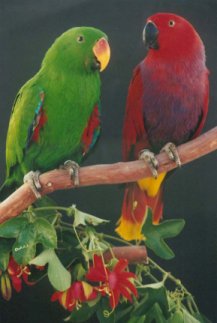 A great number of perches were placed in the open area of the large flight so the birds could establish their own territorial space without having to perch right next to a bird with whom they were not familiar. All nine birds were banded and identified as to how they were originally mated. Obviously, there was some confusion when the birds were first placed together in the large flight as they had been isolated as single pairs for several years. Our greatest concern was to keep conflicts to a minimum. But we did not have to worry about this as no bird had established its territory before the others. All of the birds were on an equal status with the others in this new area. We also removed the nest boxes within the sheltered areas to avoid having a female hide and isolate herself in a nest. A great number of perches were placed in the open area of the large flight so the birds could establish their own territorial space without having to perch right next to a bird with whom they were not familiar. All nine birds were banded and identified as to how they were originally mated. Obviously, there was some confusion when the birds were first placed together in the large flight as they had been isolated as single pairs for several years. Our greatest concern was to keep conflicts to a minimum. But we did not have to worry about this as no bird had established its territory before the others. All of the birds were on an equal status with the others in this new area. We also removed the nest boxes within the sheltered areas to avoid having a female hide and isolate herself in a nest.
During the first few days the birds very slowly began to establish their individual perch space within the open area of flight. This early behavior was confusing to me as they seemed to just mill around. They did not even stick close to their own mates, but seemed to be single birds. There were no serious conflicts whatsoever. Each bird's dominate behavior (male and female) was merely to push another bird from its perch and then occupy the space itself. There were no fights or physical attacks. It was soon apparent that we had made a very good decision in placing a large number of perches out in the open spaces. There was a lot of movement on the birds' part during this early stage.
Soon the birds settled down and began to feel comfortable in this new situation. Both males and females kept to the perches in the open areas even at night. They did not use the single perches within the small partitioned areas where the nests were to be placed. There was considerable more activity between these nine birds during the first two months than had ever been observed when they were housed as single pairs.
Although it was somewhat difficult to observe the courtship behavior between individual birds, I do know that it was going on. During this time I could not positively identify just which two birds were courting together. Many of the birds looked alike and I could not read the band numbers without entering the flight. I was aware that with all the new birds being introduced together, there was an awakening of behaviors not evident before. New birds of the opposite sex triggered new behaviors, whereas before, each bird had to respond to only one mate. This was exactly why I had wanted to try colony breeding these pairs of birds that laid only infertile eggs.

But the most unusual and exciting behavior began when the five next boxes were placed within their secluded areas approximately two months after the birds had been introduced to each other. This two month period had given the birds enough time to settle down and establish new or improved relationships. Almost immediately the four females began to investigate the nest boxes and within 40 days three of the females were incubating eggs. Within another month, the fourth female laid her eggs.
During the first month after the nest boxes were placed in the great flight, the courtship and sexual activity between the birds greatly increased. Timid males who previously dealt alone with just one female now had competition from other males. They now showed no timidity in their behavior. The males courted their females with confidence, often with a great display of head bobbing from side to side and much flaring of the pupils of the eyes. On one occasion, a male Eclectus actually hopped on to the perch before the female then hopped over her to the otherside. It was a wonderful display that I had never observed before. This is what the male Eclectus should be doing - choosing its own mate and courting her with gusto.
 It is often difficult to observe the actual breeding of Eclectus Parrots. We had often wondered if they copulated in the nest box. But in the colony environment, the now rejuvenated males mounted the females where we could easily observe. A male would be on top of the female during mating and would bob his head sideways over her head almost touching each of her cheeks during the process - a touching display of two beautiful birds of contrasting colors. It is often difficult to observe the actual breeding of Eclectus Parrots. We had often wondered if they copulated in the nest box. But in the colony environment, the now rejuvenated males mounted the females where we could easily observe. A male would be on top of the female during mating and would bob his head sideways over her head almost touching each of her cheeks during the process - a touching display of two beautiful birds of contrasting colors.
Of the four pairs of Eclectus in the colony, only two pairs produced fertile eggs from then on. But this was far better than we had done before. Of great interest was the mating of these two fertile pairs. One female kept her previous mate while the second female switched to another male. The extra male we put in the colony never did mate and continued to be isolated.
 Obviously, the colony breeding experiment with Eclectus had achieved its purpose. If all four pairs had become fertile, it would have been an even more outstanding success. Obviously, the colony breeding experiment with Eclectus had achieved its purpose. If all four pairs had become fertile, it would have been an even more outstanding success.
We left this colony intact for two years after which I decided to move the two fertile pairs to single-pair flights as they were originally housed. I planned to establish a completely different colony of Eclectus. One of the pairs that became fertile in the colony situation continued to lay fertile eggs as a pair by itself. Surprisingly, the second pair immediately began to lay infertile clutches. The lack of stimuli from other males caused this male to become intimidated by his mate. This pair was placed back into the colony.
Before long term studies of colony breeding large parrots could be done, Avicultural Institute was closed down and I have been unable to fulfill my desire to continue the work with colony breeding Eclectus and other species of parrots. I still feel that larger parrots such as African Greys, Great-billed Parrots, Caiques, etc, can be colony bred if one offers a space large enough for flight and nesting. Colony breeding is a more natural setting for parrots because it satisfies some of the needs that are fulfilled in the wild. The first and foremost is natural selection and bonding pairs. There may be other behavioral factors that colony breeding would fulfill - competition, aggression, hyperactivity, display, etc. There is so much more to learn in this area.
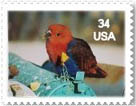
Email Me

Photography by Susie Christianİ
All Rights Reserved by respective parties. No portion of this site may be duplicated or
reused in any form without the express written permission of Susie Christian
Last Updated July 10, 2010
|
|



 In the 1980's, we housed Eclectus pairs in flights which had cement floors. Each flight was 4 ft. in width, 12 ft. in length, and 8 ft. in height. Pairs of Eclectus were not housed next to each other, but were separated by flights containing small to medium sized cockatoos (Goffin's, Citron, Red-vented, etc.). One-third and occasionally two-thirds of the cage's wire walls were covered with a solid partition. The enclosed section was always around the nest box so the inhabitants would not be disturbed by neighboring pairs of birds. In many cases (especially with the pairs laying infertile eggs), two nest boxes were hung in the aviaries, one under the shelter and the other out in the open at the far end of the flight. The standard Eclectus nest box was a grandfather type measuring 12 in. x 12 in. x 36 in. inside dimensions. Additional nest box shapes were smaller both vertically (24 in.) and in width (10 in.). With the infertile pairs, nothing seemed to work.
In the 1980's, we housed Eclectus pairs in flights which had cement floors. Each flight was 4 ft. in width, 12 ft. in length, and 8 ft. in height. Pairs of Eclectus were not housed next to each other, but were separated by flights containing small to medium sized cockatoos (Goffin's, Citron, Red-vented, etc.). One-third and occasionally two-thirds of the cage's wire walls were covered with a solid partition. The enclosed section was always around the nest box so the inhabitants would not be disturbed by neighboring pairs of birds. In many cases (especially with the pairs laying infertile eggs), two nest boxes were hung in the aviaries, one under the shelter and the other out in the open at the far end of the flight. The standard Eclectus nest box was a grandfather type measuring 12 in. x 12 in. x 36 in. inside dimensions. Additional nest box shapes were smaller both vertically (24 in.) and in width (10 in.). With the infertile pairs, nothing seemed to work. 
 A great number of perches were placed in the open area of the large flight so the birds could establish their own territorial space without having to perch right next to a bird with whom they were not familiar. All nine birds were banded and identified as to how they were originally mated. Obviously, there was some confusion when the birds were first placed together in the large flight as they had been isolated as single pairs for several years. Our greatest concern was to keep conflicts to a minimum. But we did not have to worry about this as no bird had established its territory before the others. All of the birds were on an equal status with the others in this new area. We also removed the nest boxes within the sheltered areas to avoid having a female hide and isolate herself in a nest.
A great number of perches were placed in the open area of the large flight so the birds could establish their own territorial space without having to perch right next to a bird with whom they were not familiar. All nine birds were banded and identified as to how they were originally mated. Obviously, there was some confusion when the birds were first placed together in the large flight as they had been isolated as single pairs for several years. Our greatest concern was to keep conflicts to a minimum. But we did not have to worry about this as no bird had established its territory before the others. All of the birds were on an equal status with the others in this new area. We also removed the nest boxes within the sheltered areas to avoid having a female hide and isolate herself in a nest. 
 It is often difficult to observe the actual breeding of Eclectus Parrots. We had often wondered if they copulated in the nest box. But in the colony environment, the now rejuvenated males mounted the females where we could easily observe. A male would be on top of the female during mating and would bob his head sideways over her head almost touching each of her cheeks during the process - a touching display of two beautiful birds of contrasting colors.
It is often difficult to observe the actual breeding of Eclectus Parrots. We had often wondered if they copulated in the nest box. But in the colony environment, the now rejuvenated males mounted the females where we could easily observe. A male would be on top of the female during mating and would bob his head sideways over her head almost touching each of her cheeks during the process - a touching display of two beautiful birds of contrasting colors.  Obviously, the colony breeding experiment with Eclectus had achieved its purpose. If all four pairs had become fertile, it would have been an even more outstanding success.
Obviously, the colony breeding experiment with Eclectus had achieved its purpose. If all four pairs had become fertile, it would have been an even more outstanding success. 
